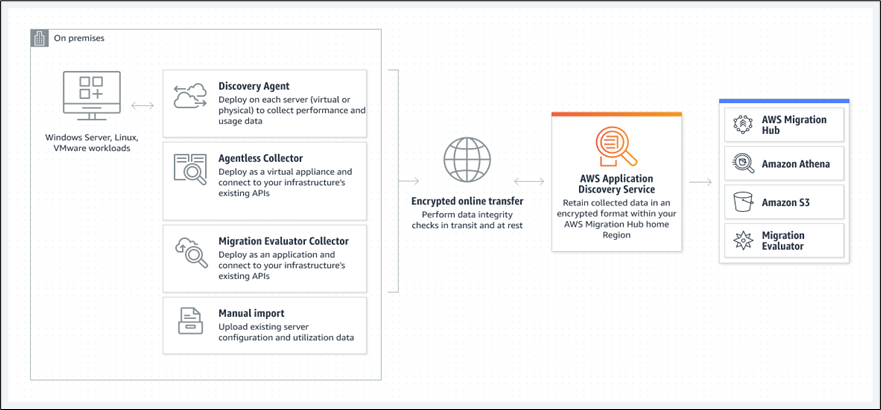AWS Application Discovery Service assists you plan your migration to the AWS cloud by accumulating usage and configuration data concerning your on-premises servers. Application Discovery Service and AWS Migration Hub together simplifies migration tracking by collecting migration status information into a single console.
AWS Migration Hub home Region stores all the data collected. That’s why home Region should be planted in Migration Hub console or with CLI commands beforehand. Insert data discovered from Application Discovery Service APIs, into cost model so that we can compute the cost of the servers running on AWS.
Some migration steps are listed down below:
![]() Evaluate your current IT inventory.
Evaluate your current IT inventory.
![]() Discover and plan.
Discover and plan.
![]() Build.
Build.
![]() Run.
Run.
AWS Application Discovery Service Workflow:

There are two ways of performing discovery and collecting data about your on-premises servers in Application Discovery Service:
- Agentless discovery can be performed by deploying the Application Discovery Service Agentless Collector (Agentless Collector) (OVA file) through your VMware vCenter. Agentless Collector gets handy in identifying virtual machines (VMs), hosts associated with vCenter and collecting static configuration data such as Server hostnames, IP addresses, MAC addresses, disk resource allocations. Additionally, it collects the utilization data for each VM and computes average and peak utilization for metrics such as CPU, RAM, and Disk I/O.
Agent-based discovery conducted by deploying the AWS Application Discovery Agent on each of your VMs and physical servers. It gets handy in gathering static configuration data, detailed time-series system-performance information, inbound and outbound network connections, and processes that are running.
AWS Application Discovery Service Agentless vs Agent
The Discovery Agent
To get started, you simply install the small, lightweight agent on your source hosts. The agent unobtrusively collects the following system information:
 Installed applications and packages.
Installed applications and packages. Running applications and processes.
Running applications and processes. TCP v4 and v6 connections.
TCP v4 and v6 connections. Kernel brand and version.
Kernel brand and version. Kernel configuration.
Kernel configuration. Kernel modules.
Kernel modules. CPU and memory usage.
CPU and memory usage. Process creation and termination events.
Process creation and termination events. Disk and network events.
Disk and network events. TCP and UDP listening ports and the associated processes.
TCP and UDP listening ports and the associated processes. NIC information.
NIC information. Use of DNS, DHCP, and Active Directory.
Use of DNS, DHCP, and Active Directory.
The agent can be run either offline or online. When run offline, it collects the information listed above and stores it locally so that you can review it. When run online, it uploads the information to the Application Discovery Service across a secure connection on port 443. The information is processed and correlated, then stored in a repository for access via a new set of CLI commands and API functions. The repository stores all of the discovered, correlated information in a secure form.
The agent can be run on Ubuntu 14, Red Hat 6-7, CentOS 6-7, and Windows (Server 2008 R2, Server 2012, Server 2012 R2). We plan to add additional options over time so be sure to let us know what you need.
The Discovery Agent
The Application Discovery Service includes a CLI that you can use to query the information collected by the agents. Here’s a sample:
 Describe-agents – List the set of running agents.
Describe-agents – List the set of running agents. Start-data-collection – Initiate the data collection process.
Start-data-collection – Initiate the data collection process. List-servers – List the set of discovered hosts.
List-servers – List the set of discovered hosts. List-connections – List the network connections made by a discovered host. This command (and several others that I did not list) gives you the power to identify and map out application dependencies.
List-connections – List the network connections made by a discovered host. This command (and several others that I did not list) gives you the power to identify and map out application dependencies.
Application Discovery Service APIs
The uploaded information can be accessed and annotated using some new API functions:
ListConfigurations – Search the set of discovered hosts for servers, processes, or connections.
DescribeConfigurations – Retrieve detailed information about a discovered host.
CreateTags – Add tags to a discovered host for classification purposes.
DeleteTags – Remove tags from a discovered host.
ExportConfigurations – Export the discovered information in CSV form for offline processing and visualization using analysis and migration tools from our Application Discovery Service Partners.
The application inventory and the network dependencies will help you to choose the applications that you would like to migrate, while also helping you to determine the appropriate priority for each one.
AWS Application Discovery Service, Launch, News The AWS Application Discovery Service is available now via our APN Partners and AWS Professional Services. To learn more, read the Application Discovery Service User Guide and the Application Discovery Service API Reference.
About the Author:

IT Leader/Cloud architect with 18+ years of global consulting experience (USA, Mexico, Japan, India and south east Asia) in areas of leadership in IT Deliveries, strategy, Project Management, Vendor Management and business/ IT transformation service, and Cloud consultancy.















































